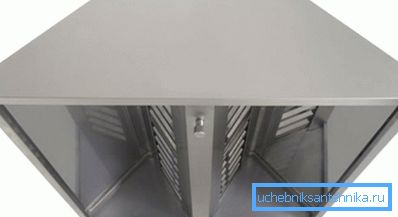Ventilation umbrella for the kitchen - the device and
In areas associated with cooking, large emissions of steam, fats, combustion products, etc., occur. To prevent their spreading to other rooms and to clear the air from them, exhaust hoods are often used. Next, we consider what these devices are, their types and features.

Device of kitchen exhaust systems
Any room has a ventilation system that provides fresh air and polluted outflow. However, for places of cooking such ventilation is not enough, because emissions, before getting into the overall system, are distributed throughout the room and mixed with clean.
Therefore, in the food industry and in domestic kitchens, local ventilation is usually used, the main element of which is an exhaust vent. Most often it is a dome-shaped structure, which is connected to a common ventilation system.

The umbrellas of the ventilation systems are made of galvanized sheet steel so that when hot air enters the duct, oxidation and even greater air pollution do not occur.
The whole structure consists, as a rule, of several basic elements:
- Box - is the main product, as it prevents the spread of emissions throughout the space of the room, and is also a housing for other parts.
- Filters - As a rule, all models are necessarily equipped with a grease catcher. In addition, they may have additional filtering systems.
- Fan - forcibly sucks polluted air inside the box. I must say that it is not available in all devices. For example, if the design is connected to the forced exhaust ventilation, then it may not have a fan.
- Air duct - the channel through which polluted air flows from the duct into the ventilation system. The diameter of the duct can be different: 110-150 mm. In addition, there are square and rectangular ducts.
Note! When working with open fire, the product must be equipped with a flame retardant filter.

Depending on the type of device, the design may have some nuances. For example, recovery ventilating exhaust umbrellas do not have a duct, as they are not connected to the general ventilation. The air in such devices passes fine cleaning and enters back into the room.
Thus, the principle of operation of the structure is quite simple - polluted air is sucked into the hood, it is being cleaned there to prevent clogging of the ventilation system, and then it is discharged through the air ducts to the outside.

Kinds
All existing kitchen umbrellas differ in several ways:
| Purpose | Can be household and industrial |
| Installation method | There are near-wall and island. |
| Form | They can be rectangular, square or round. |
| Device | As mentioned above, different models may have some structural differences. |
Next, take a closer look at the features of each type of these devices.

Household and industrial hoods
Industrial exhaust umbrella for ventilation is in many ways similar to household hoods.
The difference lies in only a few points, such as:
- Size - industrial devices have much larger dimensions, since I cover the area of industrial furnaces.
- Fan power - much higher.
- Filters - industrial extracts have special grease catchers, from which the settled impurities flow into a special glass. Such a drive should be periodically emptied and washed with soapy water. Household devices, as a rule, have paper and fiber disposable filters.
I must say that the difference between industrial and domestic hoods is sometimes not very pronounced. For example, in the cottages often install devices that are very similar in their characteristics to industrial hoods.
Note! The price of these products mainly depends on the fan power, dimensions and availability of additional functions.

Mounting methods
As mentioned above, the hood according to the method of installation are of two types:
- Island ventilation umbrellas - suspended from the ceiling. Often installed above the stoves, located in the middle of the room. As a rule, such devices contain several rows of filters.
- Walls - as easy to guess from the name, mounted to the wall. Such constructions are often installed above kitchen stoves located near the wall. It is quite simple to assemble such an extract with your own hands.
Note! When installing the hood over the stove, according to GOST on the umbrellas of ventilation systems, it should be not less than 100 mm more than the hood. This will avoid the release of harmful substances into the environment.
Here, perhaps, all the main differences of local exhaust plants, knowing that, you can choose the most suitable device for a given case.
Conclusion
Exhaust umbrellas are widespread in the home and food industry, as they provide high-quality removal of polluted air. In addition, instructions for their use and maintenance is extremely simple. The main thing is to choose the right device for each individual case, especially for industrial devices.
From the video in this article, you can learn some additional information on this topic.